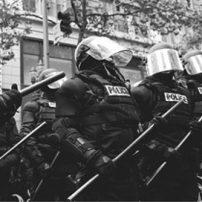
Death of a young man from police violence during an investigation. Violation of procedural and substantive part of the right to life
JUDGMENT
Yukhymovych v. Ukraine 17.12.2020 (app. no. 11464/12)
SUMMARY
Police violence, limits of its exercise, ineffective investigation and right to life. Procedural and substantive part of Article 2 of the ECHR.
The applicant’s son was shot dead by police officers during a police investigation into the crime in 1999. The criminal investigation into the death of the applicant’s son 19 years after the incident has not been completed. Authorities have not conducted an effective investigation into key aspects of the incident, and those responsible have not been punished.
The ECtHR found that with regard to the investigation into the circumstances of the applicant’s son’s death, there was a systematic delay as 19 years had elapsed, the question of the proportionality of the violence had not been assessed, the circumstances of the incident had not been clarified and no punishment had been imposed. the culprits. He considered that the investigation was ineffective and that there was a violation of Article 2 in his procedural part.
Subsequently, with regard to the use of force, in conjunction with the ineffective investigation, the ECtHR found that the essential part of Article 2 on the right to life had also been violated, as the domestic authorities had failed to prove that the use of force by police was justified and that the police operation was appropriately designed to minimize the risk to life that might arise.
The ECtHR awarded an amount of 39,000 euros for mental suffering.
PROVISION
Article 2
PRINCIPAL FACTS
The applicant, Leontiy Ivanovych Yukhymovych, is a Ukrainian national who was born in 1949 and
lives in Lviv (Ukraine).
The case concerned the death of the applicant’s son during an attempt to arrest him.
The applicant’s son Ruslan Yukhymovych was shot on 4 March 1999 when the police attempted to
arrest him in the context of a criminal investigation into extortion. He died from his injuries, caused
by two gunshots to his back.
In the first month after the fatal shooting the prosecuting authorities carried out a pre-investigation
inquiry, which resulted in a refusal to institute criminal proceedings. This decision was, however, set
aside and on 31 March 1999 and criminal proceedings were opened into alleged abuse of power by
the police causing serious harm.
According to the most recent information provided, dated from March 2018, the investigation is still
ongoing. Over the intervening years, it has been repeatedly discontinued and reopened, with
instructions from the domestic courts to the investigators to address shortcomings and take further
measures. In their decisions the domestic courts notably found that the investigating authorities had
failed to secure the crime scene and to establish whether the applicant’s son had been armed. The
courts also pointed out contradictions between the results of the forensic examinations concerning
the way and order in which the injuries had been inflicted on the applicant’s son.
In the case before the European Court, the applicant alleges that excessive force was used against
his son, while the Government submit that he died as a result of an armed clash which took place
between him and the police, following his attempt to evade arrest.
Relying on Article 2 (right to life/investigation), the applicant complained that his son had been killed
by the police and that the authorities had failed to carry out a prompt and effective investigation
into his death.
THE DECISION OF THE COURT…
The Court notes that it is common ground between the parties that the death of the applicant’s son resulted from the use of lethal force by the police.
Procedural limb
The Court reiterates that the obligation to protect the right to life under Article 2 of the Convention requires that there should be some form of effective official investigation when an individual has been killed as a result of the use of force.
For an investigation into alleged unlawful killing by State agents to be effective, it may generally be regarded as necessary for the persons responsible for and carrying out the investigation to be independent from those implicated in the events.
The investigation must also be effective in the sense that it is capable of leading to a determination of whether the force used was or was not justified in the circumstances and of identifying and – if appropriate – punishing those responsible.
Turning to the present case, the Court notes that a number of investigative steps were taken immediately after the incident. However, they did not lead to the opening of criminal proceedings until 31 March 1999, twenty-seven days after the fatal shooting when the Lviv regional prosecutor’s office set aside the earlier decision of the Mykolayiv district prosecutor’s office refusing to institute such proceedings. Furthermore, the Court observes that once opened, the subsequent investigation was characterised by repeated discontinuations and reopenings as a result of the insufficiency of the measures taken by the inquiring officers, and not following the instructions given at the reopening of the investigation. Lastly, the Court notes that the investigation into the death of the applicant’s son has been pending for more than nineteen years and that, according to the materials submitted to the Court, its outcome remains unclear. Such a delay in itself raises serious concerns as to the domestic authorities’ compliance with the requirement of promptness and reasonable expedition (see Starčević v. Croatia, no. 80909/12, § 58, 13 November 2014 with further references).
In the light of the overall length of the criminal investigation and the shortcomings described above there has accordingly been a violation of the procedural limb of Article 2 of the Convention.
Assessment of the planning and control of the operation
Turning to the facts of the present case, the Court notes that the applicant’s son was not killed in the course of an unplanned operation which gave rise to developments to which the police were called upon to react.
The Court notes that the domestic courts questioned the manner in which B.’s statement concerning the alleged racketeering had been dealt with, in particular, that the identities of the suspects had not been established and that they had not been questioned .
At the same time, as it appears from M.’s earlier testimony, when planning the operation the police did not have such information; it was only while lying in wait that they were informed by B. of the identities of the suspects and that one of the alleged racketeers had a gun. Furthermore, it can be understood from M.’s statement that the ambush was planned in order to record the extortion. The Court further notes that the subsequent proceedings cast doubt on whether the officers were clearly identifiable as police officers as they were wearing civilian clothes.
In the light of the above, the Court cannot conclude that the operation was planned and conducted in such a way as to reduce to a minimum recourse to lethal force
Assessment of the use of force
As to the use of force, the Court notes that it is confronted with fundamentally different accounts of how the applicant’s son died.
The factual circumstances surrounding the death of the applicant’s son are not clear. The domestic courts, in the course of setting aside the decisions to terminate the proceedings, repeatedly pointed out the discrepancies in the evidence as regards whether or not the applicant’s son was actually in possession of a gun .Moreover, it appears from the documents available to the Court that the only two witnesses that had consistently maintained that the applicant’s son had been armed and had posed a threat were the police officers M. and O. other witnesses had either changed their testimony during the course of the investigation or could not testify to this having been the case.
The Court further notes other omissions and shortcomings in the authorities’ investigation, in particular contradictions between the results of the forensic examinations concerning the way and order in which the injuries had been inflicted on the applicant’s son. Lastly, the Court observes that both gunshot wounds sustained by the applicant’s son were to his back .
Against this background the Court consequently has serious doubts as to how the shooting took place, in particular, whether the applicant’s son was armed and whether he posed a threat to the police officers, largely due to the manner in which the investigation has been conducted.
In view of the above, the Court concludes that the Government have not provided a satisfactory and convincing explanation of how the events in question occurred or presented solid evidence to refute the applicant’s allegations that the use of the lethal force against his son was not justified.
Having regard to the circumstances analysed above, the Government have not convinced the Court that the operation was planned and conducted in such a way as to minimise to the greatest extent possible recourse to lethal force and any risk to the life of the applicant’s son. The Government have not discharged the burden of proving that the force used by the police officers was justified; that it did not go beyond what was absolutely necessary and was strictly proportionate to the achievement of one or more of the purposes specified in Article 2 § 2 of the Convention. In such circumstances, the Court finds that there has been a violation of Article 2 of the Convention under its substantive limb.


